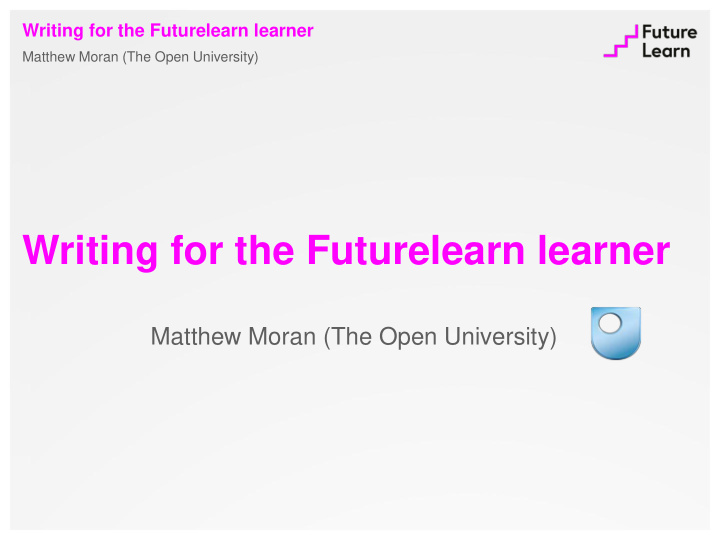



Writing for the Futurelearn learner Matthew Moran (The Open University) Writing for the Futurelearn learner Matthew Moran (The Open University)
Writing for the Futurelearn learner Matthew Moran (The Open University) Key points • Understanding the learner’s needs • Preparing to write for the Futurelearn learner • Structuring your writing • Using voice(s) • Writing learning activities • What to do and what not to do.
Writing for the Futurelearn learner Matthew Moran (The Open University) Engage
Writing for the Futurelearn learner Matthew Moran (The Open University) Preparing to engage • Understanding the learner’s needs • The age range of MOOC students • What motivates them • Their context • Their experience of online, distance education.
Writing for the Futurelearn learner Matthew Moran (The Open University) Preparing to write Beware excessive throat clearing Lengthy scene setting may help you to feel your way around but it will seem wasteful and tedious to the learner. Know where you want to go Give a confident voice and a strong lead. Sound like you know where you are going. The learner is counting on this. Get your terms straight Be clear and consistent in using terminology to refer to component parts. Don’t mix up different terms for the same things.
Writing for the Futurelearn learner Matthew Moran (The Open University) Structuring your text Planning and mapping • Devise an overarching structure or pathway for how you want the learner to progress. Use a mapping tool (e.g. Mindjet). • Communicate this pathway to the learner explicitly at the outset, implicitly thereafter. And stick to it. No deviations.
Writing for the Futurelearn learner Matthew Moran (The Open University) Structuring your text • At the micro level, plan the pathway through the individual learning asset or piece of writing. • Don’t overburden the learner in the introduction, but get straight down to business and let your voice and your signposting lead them. • Give serious thought to the system of headings.
Writing for the Futurelearn learner Matthew Moran (The Open University) Using voice(s) • Writing is the most important medium in online communication and learning. • Develop two voices. Make them distinctive but not jarringly so. • The tour guide and the romantic, intrepid traveller. • Use them to signal the parts of the text just as you would headings, boxes or other styling.
Writing for the Futurelearn learner Matthew Moran (The Open University) Writing learning activities Break it down • Activities may consist of multiple tasks. • No more than three per activity. • Make sure each task has the following: a key instruction/task one or two key resources a clear outcome/purpose a time allowance.
Writing for the Futurelearn learner Matthew Moran (The Open University) Writing learning activities Running order • Be very clear in advance what the learner has to do or think about while doing the work. • This avoids them having to break off to come back to check the instructions. • Set out the key information and guidance first, before directing the learner to the resources for the task.
Writing for the Futurelearn learner Matthew Moran (The Open University) Try it out for yourself • Once you have drafted a learning activity, try doing it yourself. • Are the instructions adequate? Are they logical? • Is it practically possible to use the resources together? (Avoid making the learner juggle unmanageable combinations of learning resources.) • Test, reflect, and rewrite if necessary. • Ideally, ask someone else to test for you.
Writing for the Futurelearn learner Matthew Moran (The Open University) What to do … • Keep it simple and get to the point quickly. • Use links to avoid repeating information found elsewhere. • If there are a lot of technical terms, put them into a glossary. • Keep it short and keep sentences and paragraphs as short as practically possible. • Use the active voice. • Use plain English when in tour guide mode.
Writing for the Futurelearn learner Matthew Moran (The Open University) More what to do … • Assess the readability of your text using the online SMOG calculator to measure your text against the National Adult Literacy Standards. • Chunk the text making clear, logical, integral sections and groupings but don’t chop it up so much that the line of argument is lost. • Keep it clear and use meaningful, well-chosen headings, sub-headings, bullet points and numbering to structure your writing.
Writing for the Futurelearn learner Matthew Moran (The Open University) And what not to do … • Don’t look forward too much and don’t be talking about Week 6 when still in Week 1. Be a tour guide, not a seer. • Don’t over -prepare the learner but give just enough information to enable the learner to progress in the moment. • Keep your own learning to yourself! If the tour guide in you is learning something for the first time, do it in private. You are supposed to have been here before. The learner wants you as a leader, not a study buddy.
Writing for the Futurelearn learner Matthew Moran (The Open University) And more what not to do … • Don’t underline words for emphasis. • Avoid italics as it’s difficult to read on screen. • Be careful with acronyms especially if you have lots. Even if you have explained an acronym elsewhere, the learner may have missed it or forgotten the meaning, and looking back is tedious and disruptive. Put acronyms and technical terminology in a glossary and provide a link. • Use bold sparingly as it looks jarring and makes the rest of the surrounding text invisible.
Writing for the Futurelearn learner Matthew Moran (The Open University) Summary • Planning, mapping, structuring • Define your terms • One step at a time • Voice and voices • Test, reflect, and redesign • Engage, engage, engage.
Recommend
More recommend